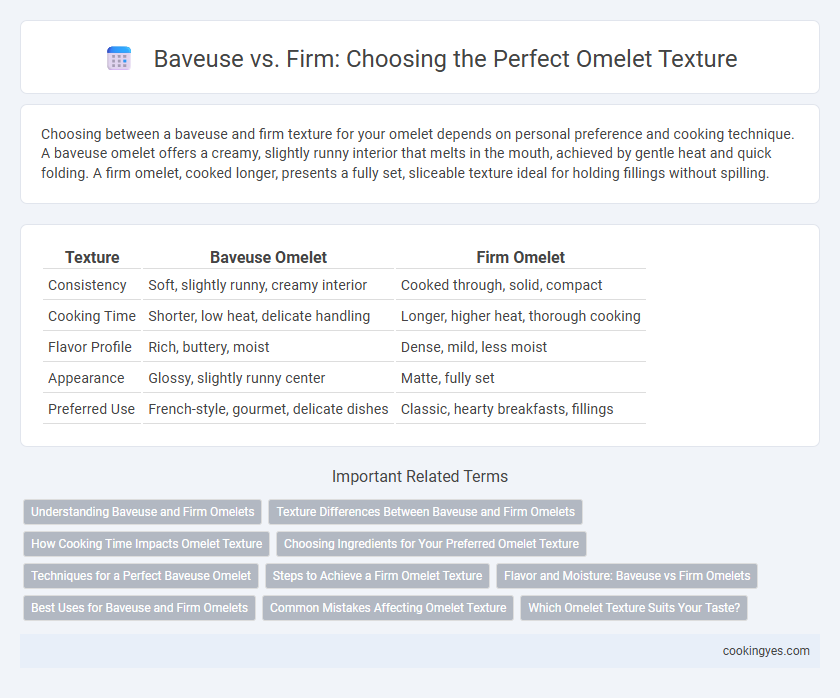Choosing between a baveuse and firm texture for your omelet depends on personal preference and cooking technique. A baveuse omelet offers a creamy, slightly runny interior that melts in the mouth, achieved by gentle heat and quick folding. A firm omelet, cooked longer, presents a fully set, sliceable texture ideal for holding fillings without spilling.
Table of Comparison
| Texture | Baveuse Omelet | Firm Omelet |
|---|---|---|
| Consistency | Soft, slightly runny, creamy interior | Cooked through, solid, compact |
| Cooking Time | Shorter, low heat, delicate handling | Longer, higher heat, thorough cooking |
| Flavor Profile | Rich, buttery, moist | Dense, mild, less moist |
| Appearance | Glossy, slightly runny center | Matte, fully set |
| Preferred Use | French-style, gourmet, delicate dishes | Classic, hearty breakfasts, fillings |
Understanding Baveuse and Firm Omelets
Baveuse omelets have a soft, slightly runny center achieved by gentle cooking at low heat, preserving a creamy texture ideal for a delicate mouthfeel. Firm omelets, on the other hand, are cooked longer until the eggs are fully set, providing a denser, more structured texture suitable for fillings that require support. Understanding the difference between baveuse and firm omelets allows chefs to tailor the cooking method for desired texture outcomes and flavor profiles.
Texture Differences Between Baveuse and Firm Omelets
Baveuse omelets have a creamy, soft texture with a slightly runny center, offering a delicate, melt-in-the-mouth experience. Firm omelets are fully cooked through, presenting a denser, more structured texture that holds shape well and provides a hearty bite. The key texture difference lies in moisture content: baveuse retains more liquid eggs, while firm omelets are cooked longer until solidified.
How Cooking Time Impacts Omelet Texture
Cooking time significantly influences omelet texture, with shorter cooking producing a baveuse, or soft and creamy interior, while longer cooking yields a firm, fully set omelet. Baveuse textures result from gently cooking eggs until just barely set, retaining moisture and a delicate, custard-like consistency. Extending heat exposure causes proteins to coagulate more fully, transforming the omelet into a firm, dense texture preferred for those who enjoy a more structured bite.
Choosing Ingredients for Your Preferred Omelet Texture
Selecting the right eggs is crucial for achieving your desired omelet texture: fresh eggs with higher moisture content produce a baveuse (slightly runny) omelet, while older eggs with firmer whites yield a firm texture. Incorporating milk or cream enhances creaminess and softness, ideal for a baveuse finish, whereas using minimal or no dairy helps maintain a denser, firmer structure. Cooking techniques like low heat and gentle stirring preserve moisture for a baveuse omelet, contrasting with higher heat and thorough folding which set a firm, stable texture.
Techniques for a Perfect Baveuse Omelet
Achieving the perfect baveuse omelet requires precise control of cooking temperature and timing to maintain its creamy, slightly runny interior. Use fresh eggs, whisked gently to incorporate air, then cook slowly over low heat while continuously stirring to create a soft, custard-like texture. Carefully fold the omelet while the center remains slightly undercooked for that signature baveuse finish, contrasting with the fully set firm omelet.
Steps to Achieve a Firm Omelet Texture
Achieving a firm omelet texture requires careful control of heat and cooking time to avoid over-softening the eggs. Start by whisking the eggs thoroughly to incorporate air, then cook them over medium heat while gently stirring until the eggs begin to set. Finish by folding the omelet decisively and allowing it to rest briefly on the pan to solidify, resulting in a consistent, firm texture rather than the soft, creamy "baveuse" style.
Flavor and Moisture: Baveuse vs Firm Omelets
Baveuse omelets, characterized by their soft, slightly runny interior, deliver a rich, buttery flavor with higher moisture content that enhances overall creaminess. Firm omelets offer a denser, more compact texture with a milder taste and lower moisture, which allows fillings to stand out more distinctly without the interference of excess liquid. Choosing between baveuse and firm omelets depends on whether a tender, flavorful bite with delicate moisture or a structured, less moist texture better suits your palate.
Best Uses for Baveuse and Firm Omelets
Baveuse omelets, characterized by their soft, slightly runny texture, are best suited for delicate fillings like fine herbs, cheese, or smoked salmon, enhancing their creamy mouthfeel. Firm omelets hold their shape better, making them ideal for hearty ingredients such as vegetables, meats, or robust cheeses, perfect for folding or rolling without breaking. Selecting between baveuse and firm textures depends on the desired presentation and filling consistency, optimizing taste and culinary experience.
Common Mistakes Affecting Omelet Texture
Common mistakes affecting omelet texture include overcooking, which leads to a firm and rubbery result instead of a soft, baveuse interior. Using excessively high heat causes the eggs to set too quickly, preventing the delicate, creamy consistency prized in baveuse omelets. Insufficient whisking or adding cold ingredients directly can also disrupt the texture, resulting in uneven firmness rather than a smooth, tender finish.
Which Omelet Texture Suits Your Taste?
Baveuse omelets have a soft, slightly runny texture with creamy curds, ideal for those who enjoy a rich, custard-like bite. Firm omelets are fully cooked through with a denser, spongier consistency, preferred by individuals who like a more structured and less moist texture. Choosing between baveuse and firm depends on your taste preference for softness versus firmness in omelet texture.
Baveuse vs Firm for Omelet Texture Infographic

 cookingyes.com
cookingyes.com